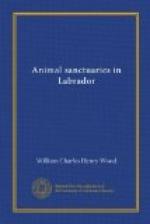We have had our warnings. The great auk and the Labrador duck have both become utterly extinct within living memory. The Eskimo curlew is decreasing to the danger point, and the Yellowlegs is following. The lobster fishing is being wastefully conducted along the St. Lawrence; so, indeed, are the other fisheries. Whales are diminishing: the Cape Charles and Hawke Harbour establishments are running, but those at L’Anse au Loup and Seven islands are not. The whole whaling industry is disappearing all over the world before the uncontrolled persecution of the new steam whalers. The walrus is exterminated everywhere in Labrador except in the north. The seals are diminishing. Every year the hunters are better supplied with better implements of butchery. The catch is numbered by the hundreds of thousands, and this only for one fleet in one place at one season, when the Newfoundlanders come up the St. Lawrence at the end of the winter. The woodland caribou has been killed off to such an extent as to cause both Indians and wolves to die off with him. The barren-ground caribou is still plentiful, though decreasing. The dying out of so many Indians before the time of the Low and Eaton expedition of 1893-4 led to an increase of fur-bearing animals. But renewed, improved, increased and uncontrolled trapping has now reduced them below their former level. Hunting for the market seems to be going round in a vicious circle, always narrowing in on the quarry, which must ultimately be strangled to death. The white man comes in with better equipment, more systematic methods and often a “get-rich-and-get-out” idea that never entered a native head. The Indian has to go further afield. The white follows. Their prey shrinks back in diminishing numbers before them both. Prices go up. The hunt becomes keener, the animals fewer and farther off. Presently hunters and hunted will reach the far side of the utmost limits. And then traded, traders and trade will all disappear together. And it might so well be otherwise.




